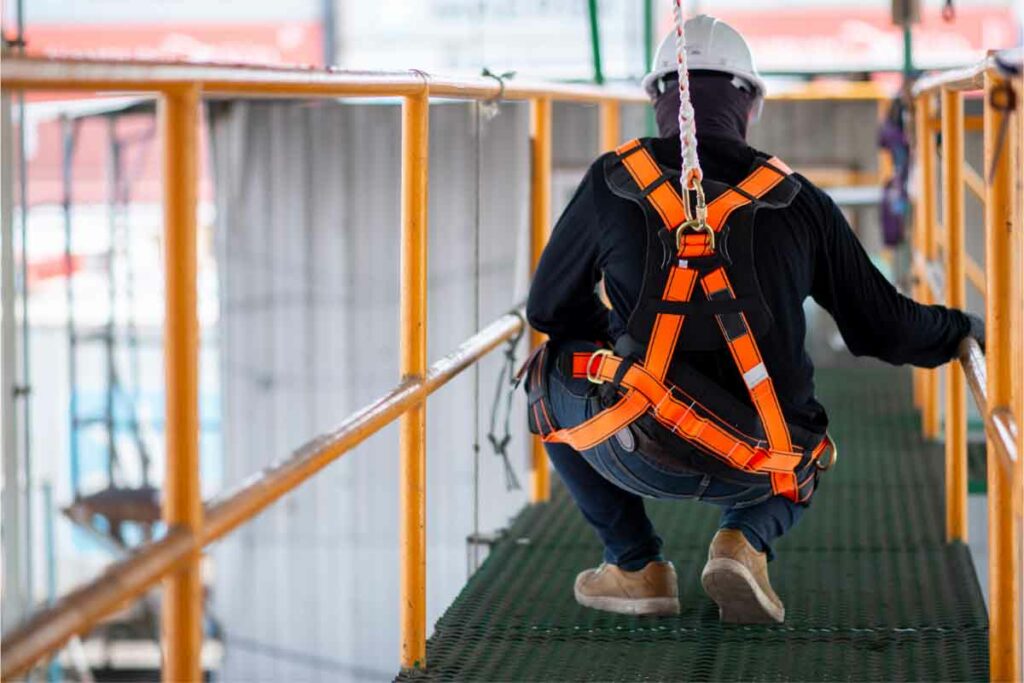Fall Protection Training
Our Fall Protection course is essential for individuals working at heights. It covers topics such as fall hazards, equipment selection and usage, and rescue techniques. By enrolling in this course, participants will gain the knowledge and skills needed to prevent falls and ensure workplace safety.
Falling is a significant hazard on many work sites and is a leading cause of worker fatalities in the construction industry. While anyone working at height will have a certain amount of risk of falling, the risk can be decreased through the use of proper safety equipment and fall protection training.
Falls are common and can result in severe injury or fatality. Because of this, proper fall protection training is crucial to keep workers safe in a variety of fields, such as construction, the oil and gas industry, and more.
Fall Protection Training For Workers Who Need It
- Roofers
- Construction workers
- Ironworkers
- Oil & gas drillers
- Aerial lift operators
- Crane installers/inspectors
- Powerline workers
- Cell tower technicians
- Window washers
Note that this is not an exhaustive list. Anyone working in a field where they are at risk of falling should obtain fall protection certification.
Make sure you and your workers are prepared with the fall protection training Canada trusts from Peak Safety Training. We offer multiple fall protection courses in order to help workers stay safer.
Some of the topics covered in Peak Safety Training’s fall protection training courses include:
- Identifying fall hazards
- The importance of fall protection from a legislative standpoint
- How to choose an anchor
- How to properly use full body harnesses
- The five classes of full body harnesses
- Requirements for connecting hardware
- The uses of various connecting devices
- The purpose and function of shock absorbers
- The hazards of not using various fall protection systems correctly
- Calculating free fall distance and clearance
- Basic requirements for fall protection plans, rescue planning, and preventing suspension trauma
- Basic inspection and care requirements
Fall Protection Training Courses
Course Topics
- Fall hazards
- The use and purpose of various fall protection systems
- The importance of fall protection from a legislative standpoint
- How to choose an anchor
- The purpose and function of full body harnesses
- The five classes of full body harnesses
- Requirements for connecting hardware
- The uses of various connecting devices
- The purpose and function of shock absorbers
- The hazards of various fall protection system components if not used correctly
- Maximum arrest force
- Calculating free fall distance and clearance
- Basic inspection and care requirements
- How to don a full body harness
- Basic requirements for fall protection plans, rescue planning, and preventing suspension trauma
- Fall protection statistics and case studies
- Fall forces and speeds
- Types of falls
- Applicable legislation, including CSA and
- ANSI standards
- Fall protection definitions
- Hazard assessment, elimination, and control
- Anchor systems
- Connecting components, including snap hooks and carabiners
- Lanyards
- Travel restraint and work positioning
- Energy absorbers
- Self-retracting devices
- Life safety ropes
- Vertical life lines and fall arrestors
- Horizontal life lines
- Full body harnesses
- Free fall and total fall distance
- Maximum arresting force
- Clearance requirements
- Swing fall hazards
- Equipment maintenance, storage, and labels
- Pre-use and formal inspections
- Manufacturer’s instructions
- Fall protection and rescue planning
- Suspension trauma
- How to Train
- Canada Standards
- Trainer Responsibilities
- Record Keeping
- Classroom set-up
- Using and Customizing Training Materials
- Fall Protection Training Outline
- Introduction
- Equipment
- Inspections
- Operations
- Hazards
- RESCUE
- Conclusion
- Final Exam
- Ladder-related hazards
- Types of ladders and their uses
- How to choose the right ladder for the job
- Components of different ladder types
- Ladder inspections and defects
- Transportation, setup, use, storage, and maintenance of portable ladders






